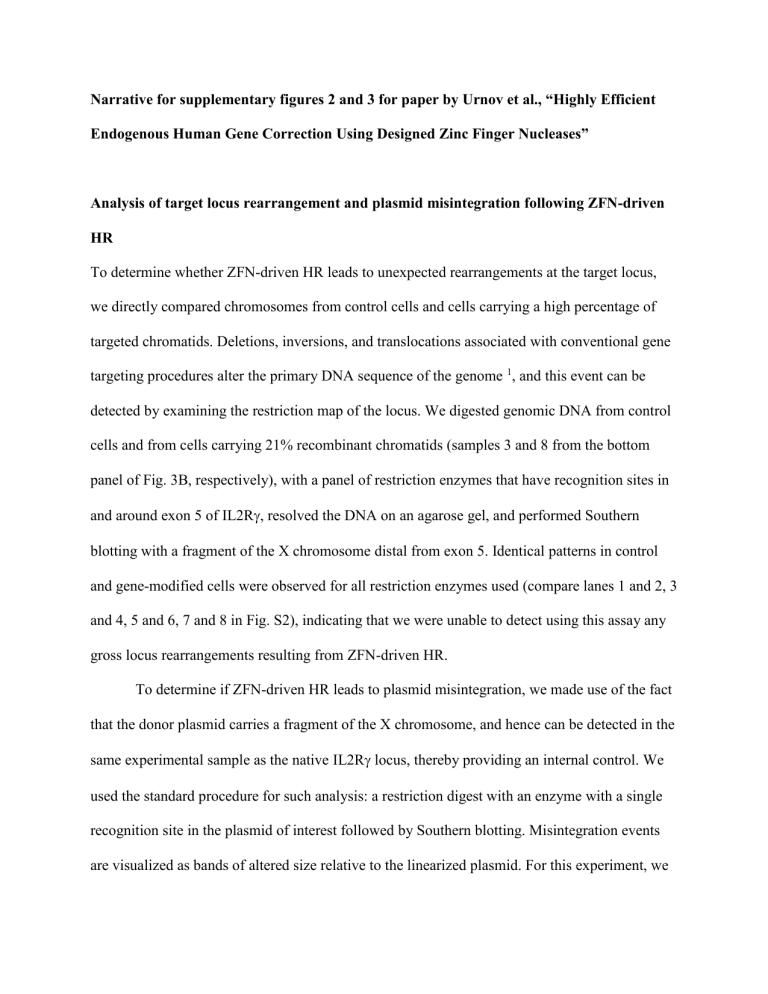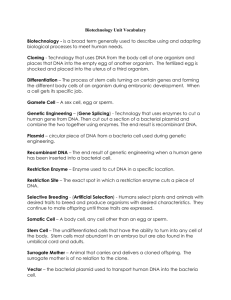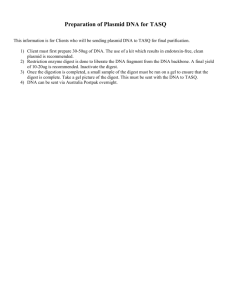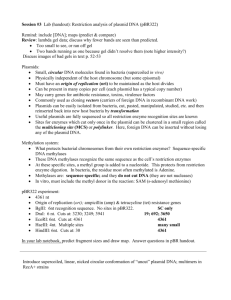Supplementary narrative and figures for reviewer #1

Narrative for supplementary figures 2 and 3 for paper by Urnov et al., “Highly Efficient
Endogenous Human Gene Correction Using Designed Zinc Finger Nucleases”
Analysis of target locus rearrangement and plasmid misintegration following ZFN-driven
HR
To determine whether ZFN-driven HR leads to unexpected rearrangements at the target locus, we directly compared chromosomes from control cells and cells carrying a high percentage of targeted chromatids. Deletions, inversions, and translocations associated with conventional gene targeting procedures alter the primary DNA sequence of the genome
1
, and this event can be detected by examining the restriction map of the locus. We digested genomic DNA from control cells and from cells carrying 21% recombinant chromatids (samples 3 and 8 from the bottom panel of Fig. 3B, respectively), with a panel of restriction enzymes that have recognition sites in and around exon 5 of IL2R
, resolved the DNA on an agarose gel, and performed Southern blotting with a fragment of the X chromosome distal from exon 5. Identical patterns in control and gene-modified cells were observed for all restriction enzymes used (compare lanes 1 and 2, 3 and 4, 5 and 6, 7 and 8 in Fig. S2), indicating that we were unable to detect using this assay any gross locus rearrangements resulting from ZFN-driven HR.
To determine if ZFN-driven HR leads to plasmid misintegration, we made use of the fact that the donor plasmid carries a fragment of the X chromosome, and hence can be detected in the same experimental sample as the native IL2R
locus, thereby providing an internal control. We used the standard procedure for such analysis: a restriction digest with an enzyme with a single recognition site in the plasmid of interest followed by Southern blotting. Misintegration events are visualized as bands of altered size relative to the linearized plasmid. For this experiment, we
used PstI, which linearizes the donor plasmid to yield a 5.5 kb fragment, and cuts out the exon 5carrying stretch of the X chromosome to produce a 2.3 kb fragment. Because plasmid donor
DNA persists in episomal form in the cells following transfection, we sought to reduce the background signal from these plasmids and facilitate the identification of potential misintegration events. Therefore we exploited a well-established approach in the DNA replication field
2
: use of DpnI to cleave the plasmid DNA which carries methylated adenine residues following growth in dam+ bacteria (genomic DNA, including misintegrated plasmid, is completely DpnI-resistant).
A large aliquot of genomic DNA from the experiment shown in Fig. 3B, bottom panel, was double-digested with PstI and DpnI, and Southern blotting was peformed with IL2R
exon
5. As expected, a 2.2 kb band corresponding to the chromosomal IL2R
DNA locus was visualized in all lanes and serves as a loading and hybridization control. In lanes transfected with the plasmid DNA encoding the donor molecule several additional bands were observed. The majority of the plasmid DNA is seen as a 600 bp band, corresponding to the unreplicated and
DpnI sensitive episome which was digested to the smallest fragment possible according to the restriction map of the locus (Referee Fig. 2B, lower panel). In addition to the DpnI sensitive material, a certain proportion of the plasmid DNA is now DpnI resistant, presumed to be due to a round of randomly initiated DNA replication, well-known to occur on episomes > 3 kb in mammalian tissue culture cells
3
. This is evidenced by is a 5.5 kb band corresponding to the lineraized episome and by a series of 8 smaller fragments – all of which can be mapped to the results of partial DpnI digestion of the PstI linearized plasmid donor DNA. Importantly, it is clear that this pattern of restriction digest is indistinguishable between samples that were received only donor DNA and samples that received both the donor DNA and the ZFNs
2
(compare starred lanes, lanes 3 and 8 in Fig. S3), and is indistinguishable between lanes that underwent low or high gene modification ( compare lanes 7 and 8 in Fig. S3). These data indicate that we do not detect using this assay donor DNA misintegration potentiated by the action of the ZFNs.
1.
2.
3.
References
Sedivy, J. M. & Joyner, A. L. Gene targeting (Oxford University Press, Oxford, 1993).
DePamphilis, M. L., ed. DNA replication in eukaryotic cells. (Cold Spring Harbor
Laboratory Press, Cold Spring Harbor, 1996).
Krysan, P. J. & Calos, M. P. Replication initiates at multiple locations on an autonomously replicating plasmid in human cells. Mol. Cell. Biol.
11 , 1464-1472 (1991).
3







